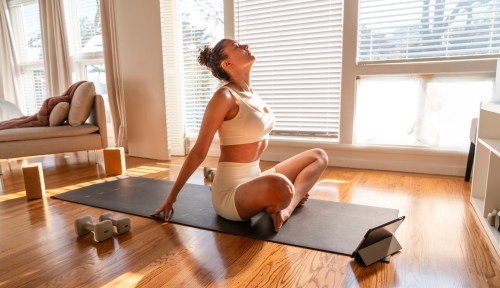Walking: It’s not just for old ladies in malls anymore. In fact, walking workouts (whether you’re doing them for your mental health or just for the “hot girl” bit) have honestly never been cooler. And the benefits of walking are extensive, such as supporting heart health and longevity and reducing stress and anxiety. Another major plus of walking? It may help reduce inflammation.
Experts in This Article
a rheumatologist based in Denver, CO
certified health coach, Pilates and fitness instructor, and founder of boutique fitness studio The Office 954 in Ft. Lauderdale, Florida
a board-certified rheumatologist
To be clear, inflammation isn’t necessarily a bad thing. It’s your immune system’s natural defense mechanism, helping detect and then attack or remove harmful bacteria, viruses, or other harmful stuff from your system. This inflammatory response can cause pain, redness, and swelling, although the specific symptoms depend on the injury, issue, and part of the body.
Ideally, inflammation is temporary: your body’s defense system spins up on response to a threat, then turns off once the threat is addressed. But sometimes, your immune system doesn’t know how to turn itself off, and keeps attacking perceived threats to your body. This is called chronic inflammation, also sometimes referred to as low grade inflammation.
“That low grade inflammation is what people specifically should know to stay away from or try and minimize,” says fitness trainer and holistic health coach Jamie Maitland. It’s characterized by overall discomfort in places like your joints, gut, or elsewhere. “You might experience pain or achey-ness.”
Chronic inflammation can be hugely harmful if untreated. It’s linked with lots of serious diseases, including type 2 diabetes, cancer, stroke, and autoimmune conditions1.
Thankfully, there are ways to mitigate inflammation in everyday life: eating certain foods that fight inflammation, managing stress (which can trigger inflammation), and yes, even working out. And no, you don’t have to commit to a daily HIIT class or train for a marathon in order to reduce your risk of inflammation. Experts say that walking on the reg can do a lot to keep inflammation at bay.
How walking helps reduce inflammation
“Physical activity, including walking, has a known anti-inflammatory effect on the body,” says Isabelle Amigues, MD, a rheumatologist based in Denver. A 2017 study published in the journal Brain, Behavior, and Immunity found that just 20 minutes of moderate treadmill exercise helped reduce inflammatory cell activity2 (specifically, production of a white blood cell involved in the immune response). Older research from 2015 also suggests that people who walk more tend to have lower levels of inflammation, although flagged that evidence is still mixed.
There are a few likely mechanisms at work.
“It improves circulation and lymphatic drainage,” says Maitland. “When your body has improved circulation, that can increase blood flow, which helps deliver oxygen and nutrients to tissues and it can help aid in the removal of waste and toxins from the body.”
Additionally, “exercise decreases the fat reserves that have been linked to driving the inflammatory process,” says Stella Bard, MD, a rheumatologist who specializes in a host of inflammatory conditions. (And walking certainly counts as exercise.) Essentially, “white adipose tissue,” a specific type of body fat, produces its own hormones and cytokines (inflammatory white blood cells); an excess of that tissue is linked to chronic inflammation3. “By moving or walking, we can help reduce the adipose tissue and thus inflammation,” says Dr. Amigues.
If you’re suffering from joint inflammation specifically, walking might be especially helpful.
Walking also supports you in other areas of your health, which can subsequently reduce inflammation. For example, walking helps lower stress4, a key inflammation trigger.
“Walking can be a stress-releasing activity, especially if practiced in a nature setting,” explains Dr. Amigues. “Walking can also help with better sleep quality, and we know that sleep quality is paramount to help our immune system.5”
How much walking does it take to decrease inflammation?
There’s no hard-or-fast rule on how long you need to walk every day to decrease inflammation. But Dr. Bard suggests building up to walking 30 minutes a day, five days per week—on par with the weekly exercise recommendations from the Centers for Disease Control and Prevention (CDC). Another way to split that up is by walking 10-15 minutes every day, and then adding in a couple days with longer 30 minute walks, advises Maitland.
If you haven’t been walking consistently, you should start slowly and build up gradually with your walking workouts in terms of the duration, intensity, and frequency.
“Starting with a one-hour high-intensity fast-paced walk if there has been no exercise prior regularly can lead to more harm,” warns Dr. Amigues. “I recommend aiming to build up slowly, in increments of 10 minutes, up to 40 minutes per day of fast-paced walking. The idea is to walk just fast enough to feel your heart rate go up a little bit.”
Dr. Amigues says that if you are walking to reduce inflammation and improve your health, the goal should be to walk every day, and be consistent. “Walking very fast for very long one day every month is not as helpful as a moderately fast pace walk that lasts 40 minutes every day,” she notes.
Can walking ever increase inflammation?
Dr. Amigues says that regular moderate-intensity physical activity, performed consistently, is generally anti-inflammatory for the body. However, there are some cases where walking or other forms of exercise can lead to complications, including increased inflammation.
“Overtraining and overusing the joints, injury, lack of recovery, as well as dehydration, among others can increase inflammation,“ warns Dr. Amigues. “Patients should stay well hydrated and walk at a moderate pace, increasing the duration and intensity over time to prevent such complications.”
Other exercises that may reduce joint pain and inflammation
Dr. Amigues says that in addition to walking for exercise, any form of low-intensity exercise tends to be a good option for patients who have inflammatory conditions like rheumatoid arthritis (RA), chronic pain, and more.
“Qi-gong and tai chi, which we know also help with fibromyalgia, are great,” Dr. Amigues says. “Swimming is a wonderful workout, as it allows for exercise without resistance,” she adds (which can be easier on joints and allow people to work out longer without pain). “Yoga can also be a good source of exercise but for some patients, this may take some time.”
You can also take your walking workouts to the next level by adding in some resistance training elements.
“If you’re wanting to bump it up a little bit, you can always opt for a weighted vest,” Maitland says.
Even if you don’t love walking, or you want to supplement your walking workouts with other forms of exercise to decrease inflammation (and the pain associated with inflammatory conditions), there are several options to choose from. According to Dr. Amigues, “the goal is to enjoy the exercise we do and do it consistently.”
Furman, David et al. “Chronic inflammation in the etiology of disease across the life span.” Nature medicine vol. 25,12 (2019): 1822-1832. doi:10.1038/s41591-019-0675-0
↩︎Dimitrov, Stoyan et al. “Inflammation and exercise: Inhibition of monocytic intracellular TNF production by acute exercise via β2-adrenergic activation.” Brain, behavior, and immunity vol. 61 (2017): 60-68. doi:10.1016/j.bbi.2016.12.017
↩︎Park, Young-Min et al. “Adipose tissue inflammation and metabolic dysfunction: role of exercise.” Missouri medicine vol. 111,1 (2014): 65-72.
↩︎Edwards, Meghan K, and Paul D Loprinzi. “Experimental effects of brief, single bouts of walking and meditation on mood profile in young adults.” Health promotion perspectives vol. 8,3 171-178. 7 Jul. 2018, doi:10.15171/hpp.2018.23
↩︎Mullington, Janet M et al. “Sleep loss and inflammation.” Best practice & research. Clinical endocrinology & metabolism vol. 24,5 (2010): 775-84. doi:10.1016/j.beem.2010.08.014
↩︎
Sign Up for Our Daily Newsletter
Get all the latest in wellness, trends, food, fitness, beauty, and more delivered right to your inbox.
Got it, you've been added to our email list.











